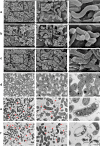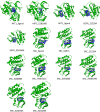In vitro anti-bacterial activity and network pharmacology analysis of Sanguisorba officinalis L. against Helicobacter pylori infection
- PMID: 33865425
- PMCID: PMC8052767
- DOI: 10.1186/s13020-021-00442-1
In vitro anti-bacterial activity and network pharmacology analysis of Sanguisorba officinalis L. against Helicobacter pylori infection
Abstract
Background: Helicobacter pylori (H. pylori) infection has become an international public health problem, and antibiotic-based triple or quadruple therapy is currently the mainstay of treatment. However, the effectiveness of these therapies decreases due to resistance to multiple commonly used antibiotics. Sanguisorba officinalis L. (S. officinalis), a traditional Chinese medicine clinically used for hemostasis and treatment of diarrhea, has various pharmacological activities. In this study, in vitro antimicrobial activity was used for the preliminary evaluation of S. officinalis against H. pylori. And a pharmacology analysis approach was also utilized to elucidate its underlying mechanisms against H. pylori infection.
Methods: Micro-broth dilution method, agar dilution method, checkerboard assay, scanning electron microscopy (SEM), and transmission electron microscopy (TEM) were used for the assessment of anti-bacterial activity. Active ingredients screening, GO analysis, KEGG analysis, construction of PPI network, molecular docking, and RT-qPCR were used to elucidate the underlying pharmacological mechanisms of S. officinalis against H. pylori infection.
Results: The minimum inhibitory concentration (MIC) values of S. officinalis against multiple H. pylori strains including clinically isolated multi-drug resistant (MDR) strains were ranging from 160 to 320 µg/ml. These results showed that S. officinalis had additive interaction with four commonly used antibiotics and could exert antibacterial effect by changing the morphology of bacteria without developing drug resistance. Through network pharmacology analysis, 8 active ingredients in S. officinalis were screened out for subsequent studies. Among 222 putative targets of S. officinalis, 49 targets were identified as potential targets for treatment of H. pylori infection. And these 49 targets were significantly enriched in GO processes such as protein kinase B signaling, protein kinase activity, protein kinase binding, and KEGG pathways such as Pathways in cancer, MicroRNAs in cancer, and TNF signaling pathway. Protein-protein interaction analysis yielded 5 core targets (AKT1, VEGFA, EGFR, SRC, CCND1), which were validated by molecular docking and RT-qPCR.
Conclusions: Overall, this study confirmed the in vitro inhibitory activity of S. officinalis against H. pylori and explored the possible pharmacological mechanisms, laying the foundation for further research and clinical application.
Keywords: Active ingredients; Antibacterial; Helicobacter pylori; Network pharmacology; Sanguisorba officinalis L..
Conflict of interest statement
The authors declare that they have no competing interests.
Figures







Similar articles
-
In vitro anti-bactrical activity and its preliminary mechanism of action of the non-medicinal parts of Sanguisorba officinalis L. against Helicobacter pylori infection.J Ethnopharmacol. 2024 Jan 10;318(Pt B):116981. doi: 10.1016/j.jep.2023.116981. Epub 2023 Aug 11. J Ethnopharmacol. 2024. PMID: 37574016
-
Elucidation of the molecular mechanism of Sanguisorba Officinalis L. against leukopenia based on network pharmacology.Biomed Pharmacother. 2020 Dec;132:110934. doi: 10.1016/j.biopha.2020.110934. Epub 2020 Nov 1. Biomed Pharmacother. 2020. PMID: 33254437
-
Network Pharmacology and Transcriptomic Sequencing Analyses Reveal the Molecular Mechanism of Sanguisorba officinalis Against Colorectal Cancer.Front Oncol. 2022 May 12;12:807718. doi: 10.3389/fonc.2022.807718. eCollection 2022. Front Oncol. 2022. PMID: 35646655 Free PMC article.
-
Network pharmacology-based approach to investigate the molecular targets and molecular mechanisms of Rosmarinus officinalis L. for treating aging-related disorders.Biogerontology. 2024 Oct;25(5):793-808. doi: 10.1007/s10522-024-10122-w. Epub 2024 Jul 17. Biogerontology. 2024. PMID: 39017748 Review.
-
Phytotherapeutic Activities of Sanguisorba officinalis and its Chemical Constituents: A Review.Am J Chin Med. 2018;46(2):299-318. doi: 10.1142/S0192415X18500155. Epub 2018 Feb 12. Am J Chin Med. 2018. PMID: 29433389 Review.
Cited by
-
A comprehensive review on traditional uses, phytochemistry and pharmacological properties of Paeonia emodi Wall. ex Royle: current landscape and future perspectives.Chin Med. 2023 Mar 2;18(1):23. doi: 10.1186/s13020-023-00727-7. Chin Med. 2023. PMID: 36859262 Free PMC article. Review.
-
In vitro anti-Helicobacter pylori activity and antivirulence activity of cetylpyridinium chloride.PLoS One. 2024 Apr 11;19(4):e0300696. doi: 10.1371/journal.pone.0300696. eCollection 2024. PLoS One. 2024. PMID: 38603679 Free PMC article.
-
Asclepain cI, a proteolytic enzyme from Asclepias curassavica L., a south American plant, against Helicobacter pylori.Front Microbiol. 2022 Aug 18;13:961958. doi: 10.3389/fmicb.2022.961958. eCollection 2022. Front Microbiol. 2022. PMID: 36060760 Free PMC article.
-
In vitro anti-Helicobacter pylori activity and the underlining mechanism of an empirical herbal formula - Hezi Qingyou.Front Microbiol. 2024 Feb 19;15:1355460. doi: 10.3389/fmicb.2024.1355460. eCollection 2024. Front Microbiol. 2024. PMID: 38440143 Free PMC article.
-
Chebulinic acid isolated from aqueous extracts of Terminalia chebula Retz inhibits Helicobacter pylori infection by potential binding to Cag A protein and regulating adhesion.Front Microbiol. 2024 Oct 2;15:1416794. doi: 10.3389/fmicb.2024.1416794. eCollection 2024. Front Microbiol. 2024. PMID: 39421559 Free PMC article.
References
Grants and funding
LinkOut - more resources
Full Text Sources
Other Literature Sources
Research Materials
Miscellaneous

